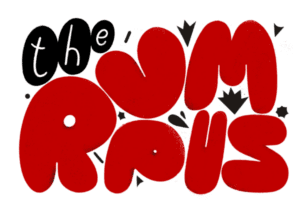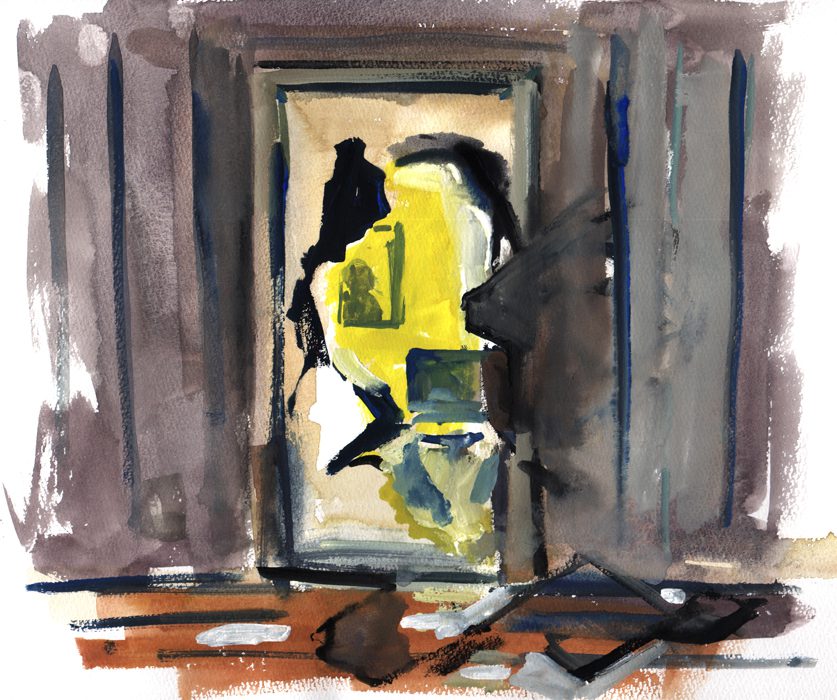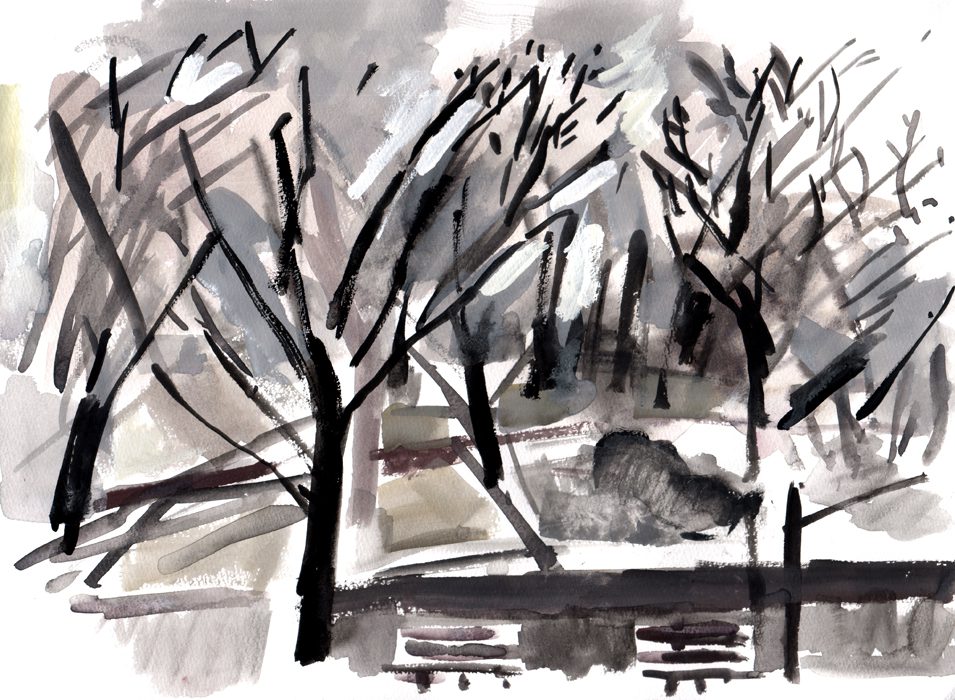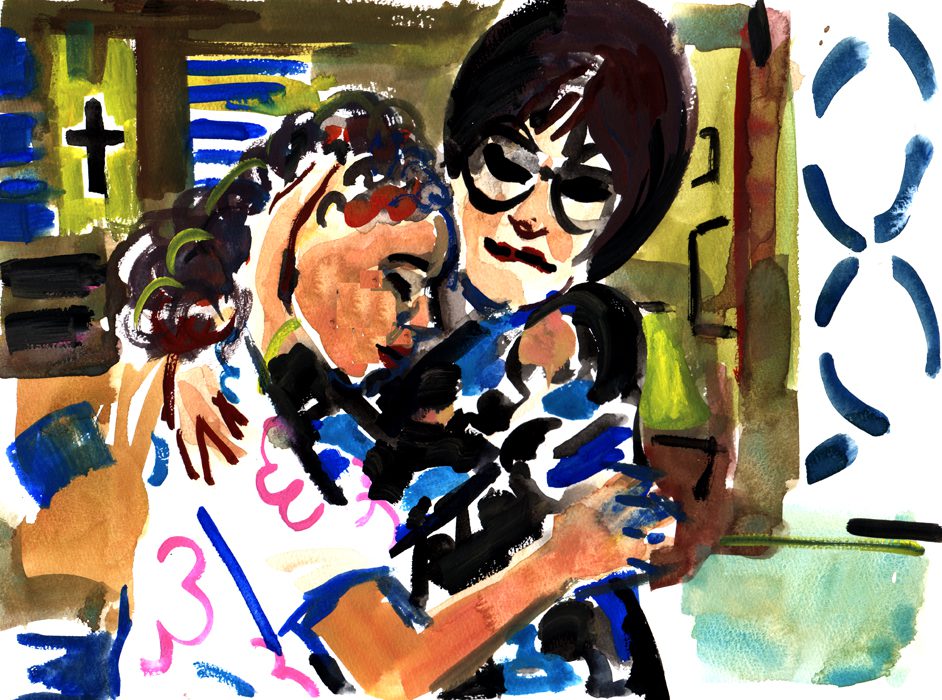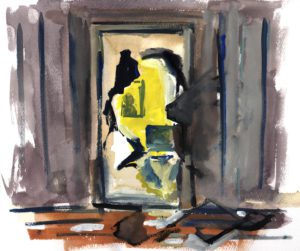
When I was a kid, Mom would lock herself in her room. We could hear her whimpering through the splintered door. Her partner Millie had to rebuild that door out of cheap plywood whenever she had to break it down to get to Mom. She rebuilt it so many times.
Millie knocked on the door first, “Abreme. Por favor, open the door.” The knocks were soft at first. There was no pause in Mom’s crying.
None of us three kids ever dared knock. My brother, sister and I were afraid of what we would see. In what condition we’d find our mother. If we could hear she was crying, at least we knew she was alive. At least we knew she hadn’t hurt herself.
Millie and mom’s fights were vicious and often violent, and it was usually after one of these fights that mom reeled, but it was only Millie who could get mom out of that room. We kids watched, at once terrified and enthralled.
I remember wanting to run out to the backyard to climb up the plum tree into the land I created in the stories I told myself of another life where my mother didn’t have these breakdowns. I also wanted to save my mother. I thought: Maybe if I do well in school, mom will be okay. Maybe if I don’t fight with my sister Dee… If I keep my drawers clean…
Millie sent one of us up to her mother’s apartment on the second floor. She consulted Doña Carmen on all things holy and not. Doña Carmen rushed down with the other women, her daughter Haydee and our other neighbor Luisa, the same woman we heard beating her pre-teen daughter at night, calling her puta and sucia.
When Mom finally emerged from the room, she leaned all her weight on Millie so she looked like she was being dragged. Her eyes were swollen, her hair plastered to her face, and her tattered nightgown was wet with tears and snot, and sometimes her urine.
It was around this point that we got the stern eye from Doña Carmen, who thought this was no place for kids. She’d send Haydee to shoo us into our room and slam the door. I’d peek through the crack in the frame, hoping to see my mother. I could hear the beads of the rosaries and the prayers.
Santa Maria, Madre de Dios, ruega por nosotros pecadores, ahora y en la hora de nuestra muerte. Amen.
These were psychotic breaks. What mom needed was a psychiatrist. She needed therapy. She maybe even needed medication.
For a long time I didn’t know what they did when they dragged my mother into the bathroom, but one day, I sneaked out of the room and crawled to the bathroom where I saw my mother, stripped down in the tub. She was crying and rocking herself, while the woman prayed over her, splashing her with agua florida and brandishing the cross over her. I didn’t know until many years later that what they were doing was performing a Boricua campo style exorcism.
They were treating my mother like she was possessed.
The first time I realized this was when I saw the movie The Exorcist when I was ten, but the idea scared me so bad, I willed it out of my mind. By then I had experienced enough abuse and trauma that I’d gotten good at pushing memories down and out of me, or at least I’d gotten good at trying to. I could never watch a horror movie after that.
I crawled back to our room and refused to answer when my brother and sister me what I saw. I got into the bottom bunk, covered myself with blankets and squeezed my hands together to pray. I begged god to help my mother, and made all sorts of promises I could never keep—I’d be a good little girl, I’d never disobey mom again. Por favor, diosito, please please please, make mommy okay. Afterwards, my hands ached from all that wringing and praying.
It took hours but eventually mom snapped out of it. She slept for a while, and when she emerged, I stayed out of her way until she was back to being herself, cooking and swatting at me when I passed by. Singing along to the ballads on her favorite radio station, Super KQ, like it never happened.
I went to the university’s counseling services once, “for my anxiety” as my referring resident advisor put it. I hadn’t told her what I was anxious about and the therapist I met with reminded me of why.
I spoke to a white woman with large glasses and wiry blonde hair. I was eighteen and in an abusive relationship with a drug dealer. I didn’t need to be scolded or shamed for it. It was stupid, yes. I know that now, but by then I had been on my own since I left my mother’s house at thirteen to attend boarding school. I was with that man because he had been there for me when I was lonely and lost and dealing with my mother’s absence from my life. Instead of digging into the wounds that lay at the core of that reckless behavior, the therapist wondered out loud how someone like me, a brown girl from Bushwick, Brooklyn, could be sitting there, at an Ivy League university while dating a drug dealer from Washington Heights. I was ungrateful. I was ridiculous. I deserved what was happening to me. She may not have used those exact words but that’s how she made me feel.
I didn’t go back to therapy until my brother died when I was thirty-seven and I was sent reeling into the darkest place of my life, staring at my own splintered door.
How did I cope until then? I didn’t. For much of my twenties, I hurled myself into the New York City nightlife scene with its bottomless supply of drugs and alcohol, blunts packed with twenty-dollar bags of weed and my favorite and most relentless addiction: emotionally unavailable men. I know now that I was already in that room, beyond the splintered door, but it took my brother’s death to really look at my life and what I was doing to myself. I’m still learning how to be tender to the Vanessa I was then.
When I had my daughter, I abandoned the club scene and threw myself into motherhood and writing. When I was pregnant I started writing again after years of ignoring the pull to the page. I knew what misery looked like, because I’d seen what it’d done to my mother and our family. I wanted to give my daughter a better life, so when I examined mine, I knew that it was writing that had saved me when I was a kid, climbing up that plum tree to tell myself stories. I filled seven journals while I was pregnant, and I wrote my first novel when my daughter was months old. I haven’t stopped writing since.
What I didn’t know then was that it would be my daughter and writing that would save me.
When my brother died, I turned to the only thing that had proven helpful to me in the past—my writing. I was trying to write myself out of the well of my depression. My mother had walked out of my life again, and I felt like I was suffocating. But I also knew that I needed to bring some light into my daughter’s life. My daughter who was watching her mother unravel, like I watched my mom unravel when I was a little girl. I thought back to that splintered door and to my hands that ached from praying. I knew I couldn’t let my daughter carry my pain, so I hid it from her, in a feeble attempt to protect her from my grief.
I held the tears in until she was asleep at night, then I’d fall apart. One day, I was struggling to hold it in. I yelled at her. I snapped. At one point, she stared at me and said, “Mommy…” It was so quiet and so pained. I turned to find her staring, her eyes brimming with tears. I fell back onto the chair, put my face in my hands and started sobbing. That’s when my baby girl walked over, put her arms around me and started whisper, singing a song I’ve been singing to her since she was in my belly: “You’re just too good to be true. Can’t take my eyes off of you…”
That day, my daughter gave me permission to do what I hadn’t been given permission to do since I was that little girl, watching that splintered door: grieve.
Six months after my brother died, my daughter started refusing to go with her dad for her weekend visits. She’d been going to her father’s house every other weekend for eight years, so I was surprised by this, but I thought it would pass. I was wrong.
The next time visitation came around, my usually mild-mannered, all-the-time-chill nine-year-old had an all-out panic attack. She cried and screamed that if I loved her, I wouldn’t make her to go. “I don’t wanna leave you, mommy. I just wanna be with you.”
When I spoke to her father, he tried to get me to use force, and he was totally against therapy when I suggested it. He’s from the school of “if you go to therapy, it’s ‘cause you’re crazy.” I know that school, I was raised in it too, but I knew she needed help.
It took a while to find a therapist for her. I discovered that there’s a plethora of mental health options for preteens and teens but younger sector is pretty under-provided for. When I finally found a therapist on the Upper West Side of Manhattan, I was a little confused when she told me she wanted to meet with me first.
I wasn’t nervous until I got out of the B/C train station on 72nd Street and Central Park West. The wind rustled the trees in the park. They were naked but still so pretty with their sharp edges poking into the gray sky.
The waiting room was all dark wood and dim lamp lights. It reminded me of a college dean’s office. There was the staple fake plant in the corner that looks real but you’ve seen so many of them, you know it can’t be. There were National Geographic magazines on the round center table and a few Highlights for the kids, so I knew at least one of the therapists specialized in children. There were even a few Psychology Today magazines. I was reaching for one when she came out of her office.
The therapist, we’ll call her Kay, was in her early fifties, with roots that needed to be touched up badly, glasses that were held up by the tip of her nose, and a waifish figure that was not complemented by her too-large suit.
The first thing I noticed when I entered her office was that she had no computer. Unlike the waiting area, it was brightly lit and had hardly any wood at all. In fact, it was mostly white, except for the throw on the couch and the rug on the floor.
She signaled for me to sit either on the couch or the chair in front of hers. I opted for the chair. I mean, I wasn’t the one getting therapy.
She ruffled through some papers, grabbed a pen from her desk, pushed her glasses up her nose (by that time I wondered how they were still on), and looked at me with a small smile. She was pleasant. Professional. I wasn’t going to be inviting her out to coffee anytime soon and we’d definitely never share a pitcher of sangria at my favorite spot, Camaradas, but I felt safe enough.
“So, how do you pronounce your daughter’s name?” She proceeded to ask me basic questions about my daughter: her age, grade, hobbies.
“So, what’s been going on?”
“I don’t understand,” I stammered. “Shouldn’t you be asking her that?”
“Well, yes, I will, but I thought I’d ask you first. You’re her mother, so what’s going on with you is what’s going on with her.”
I felt the knot build in my chest but I swallowed it down and started. I told her about my brother Carlos’s death and everything that happened after; how mom had stopped talking to us, how my daughter’s godmother had abandoned her, how she stopped dancing because it was just too much for me to keep up with while I was grieving. “It’s a lot for a nine-year-old,” I said. I gasped for air. I hadn’t realized that I’d been holding my breath.
Kay leaned back in her chair and folded her hands on her lap. “That’s a lot for you, too.”
I started heaving and crying and could do nothing to make it stop. Kay didn’t rush me. She passed me a box of tissues and waited. She didn’t stare but she didn’t look away either. She just waited for me to get myself together.
“I’m sorry,” I said, over and over. “I’m sorry.”
She nodded softly and waited. Then she said, “You know, taking care of yourself is taking care of your daughter.” I was a blubbering mess when I walked out of there, but I knew I needed to get myself help, too.
I started therapy the week after my little girl did. Within three months, baby girl was easing her way back into her weekend routine with her dad, and I was getting a hold of my grief through weekly therapy sessions that cost me seventy-five dollars a pop, but were worth every penny.
For the first time, a stranger validated my feelings. My therapist, we’ll call her B, explained so many things in ways that I could wrap my brain and heart around. When I explained my childhood and how I’d always been made to feel like I was too sensitive—“ay, a ti no se te puede decir nada,” mom would say—my therapist said, “When you deny someone their emotions, you deny them their existence.”
To this day I wonder: Is this is what happened to my mother? Is this why she’s never been able to get over the things that happened to her? Is this what she relived every time she locked herself behind that splintered door?
B helped me see that I wasn’t just mourning my brother; I was also grieving my mother. She helped me forgive myself for walking away from my mother, reminding me that I didn’t deserve to be treated so cruelly, and putting myself first was a matter of self-preservation for both me and my daughter.
Later, my daughter revealed that seeing me cry helped her grieve. She also confessed that when she didn’t want to go to her dad’s, it was because she was afraid I was going to hurt myself.
I think about this when I go to therapy every Friday. I think about how different my daughter’s life is because her mother is working on her own healing. I think about how we talk like my mom and I never did, and still don’t. I share what I learn in therapy and am open about my feelings, even the complicated ones. I no longer hide my tears from my daughter.
I think about how different my childhood would have been had my mother had access to the mental health services she needed. The ones she still needs but refuses.
I recently watched a One Day at a Time episode that’s stayed with me. The main character, Penelope Alvarez, is a vet who struggles with depression, anxiety, and PTSD. She decides to discontinue her meds because she’s worried the man she is dating will leave her if he finds out. She’s internalized the stigma around mental illness that her mother parrots when she refers to Penelope’s group therapy as her “cuckoo party.”
I thought of my mother, who’s said therapy and meds are “pa’ los locos.”
Penelope’s behavior becomes erratic and hostile. In the big, rock-bottom scene, she follows her counselor’s suggestion and records her thoughts, but she can’t bring herself to listen to the soliloquy alone, so she seeks support from her best friend and landlord, Schneider.
As I watched, I flashed to the many moments in my life when I’ve said these same things to myself: You’re worthless. You’ve failed your daughter. She’d be better off without you. Nothing you’ve done amounts to anything.
I remembered the times people around me told me: You should be happy, you’ve accomplished so much, your daughter is healthy and thriving. Look at what you’ve done with your life: your education, your books, your writing! Why couldn’t I see that?
I didn’t have anyone to tell me what Schneider told Penelope: “A healthy brain doesn’t say those things.”
My mother didn’t have anyone to tell her that an exorcism would not heal her.
It took me a long time to realize that my brain wasn’t functioning like a healthy brain. The realization came to me in bits and pieces, accumulating like a collage I couldn’t understand until I had the pieces in front of me. When I stare at the collage, like I do in therapy every Friday, I see how unstable my mental health has been throughout much of my life.
It took my brother’s death and my daughter’s anxiety attacks to make me realize that I needed and wanted to be well, and that I couldn’t do it alone.
My brain still tells me terrible things sometimes. This journey is ongoing. But I know this: my daughter will never have to break down a door. Yes, it is difficult to show her my wounds, but if I can leave her with anything, let it be this: we all deserve to be well.
***
Rumpus original art by Dmitry Samarov.
